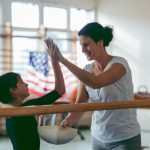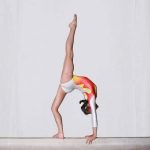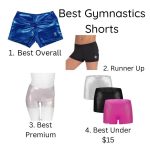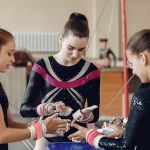
Gymnastics Skills List: Your Guide to Essential Floor Moves in Gymnastics. This collection is perfect for anyone looking to learn or advance in the sport.
We’ll dive into the details of each skill, offering insights into their importance and the role they play in a gymnast’s journey.
Let’s get started!
Disclaimer: Gymnastics carries an inherent level of risk. Information contained in this article does not replace the need for professional coaching in a recognized gymnastics facility.
I’m often asked which are the skills that a gymnast should learn first. A Beginner gymnastics skills list will include rolling, jumping and landing, handstands, cartwheels, and this article will look at each skill in detail.
But before learning even the most basic of gymnastics skills, you should be familiar with the common body shapes used in gymnastics such as tuck and pike shapes.
Once a gymnast has mastered these essential skills with good technique, they will be ready to progress onto more advanced gymnastics moves.
Forward Roll
The forward roll is essential for beginners as it teaches basic rotation, a key element in advanced skills like somersaults and handsprings.
By learning a basic forward roll, the gymnast becomes comfortable with going upside down and changing their body shape to help speed up rotation. The most common shape to use in a forward roll is a tucked shape.
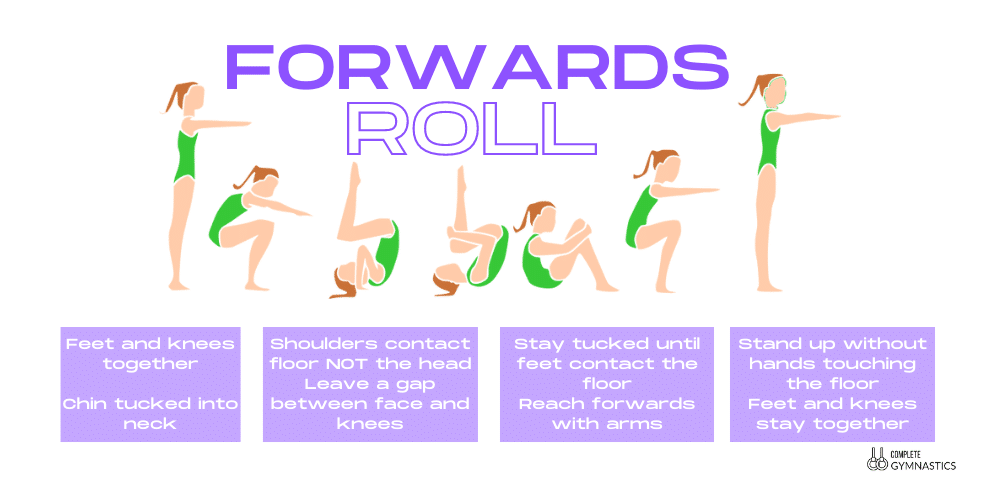
Backward Roll
The backward roll is challenging for beginners, as the head often touches the floor. With practice, using the hands takes weight off the head and shoulders, making the roll smoother.
Backward rolls are a great help to prevent injury. Advanced gymnasts performing backward skills such as back handsprings and back somersaults use the backward roll to recover from a loss of balance. This is especially important when the skills are being performed with a lot of speed and power and it is just too hard to stop still on a landing.
There are many variations of the backward roll which use different body shapes.
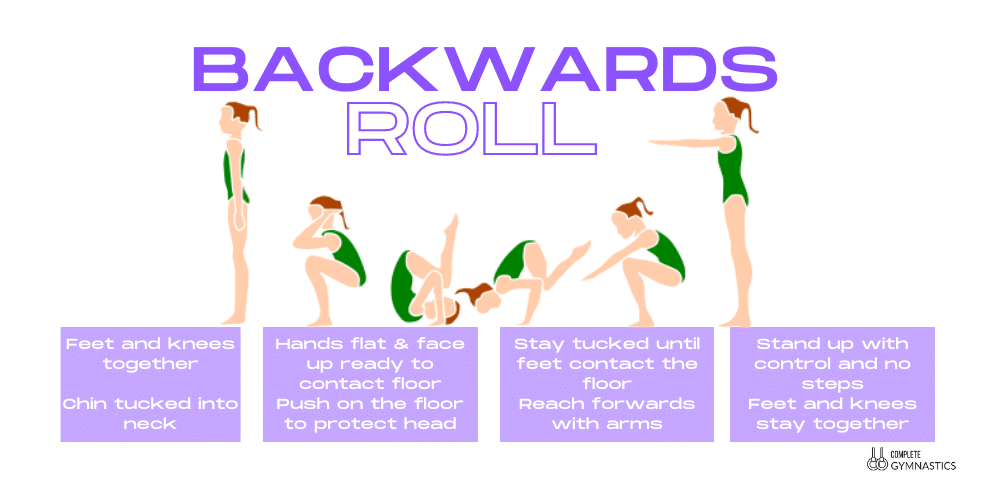
Handstand
The handstand is a key skill in gymnastics and serves as a foundation for many advanced moves.
The ability to support your body weight, the body shape and body tension needed to hold a good handstand are repeated throughout the sport.
Handsprings and round-offs are two advanced skills that use the handstand shape. The body passes through the handstand form without holding it still.Handstand shapes are used on bars, vault, beam and pretty much every other type of gymnastics apparatus.
If there’s one skill you should focus on mastering, it’s the handstand.

Cartwheel
The cartwheel is essential for beginners. Many learn it on their own, but for some, mastering it is a big achievement.
It is a bit of a milestone for beginner gymnasts, probably because you can show it off pretty much anywhere!
Good technique is important and so is neatness such as pointed toes and straight arms. Many self-taught gymnasts have to re-learn the correct hand placement when they start a beginner’s gymnastics class.
Did you know that only one hand at a time is supposed to contact the floor? Many gymnasts don’t and they simply plonk both hands down at the same time which can slow down or even stop the legs from traveling smoothly over the head.
Bridge
The Bridge is the first flexibility-based skill I’ve added to this beginner’s gymnastics skills list.
Many believe back flexibility is the key to learning a bridge, but shoulder flexibility is more important. Stiff shoulders often make it hard for beginners to push up from the floor.
There are lots of stretching exercises that can help improve shoulder flexibility and with enough practice, most gymnasts can master a good bridge. Once you have it, the bridge will improve your handstands and all of the skills related to a handstand such as back handspring.
Arabesque (scale)
Balance is key in gymnastics, especially on beam and learning the arabesque helps beginners develop strong balance skills.
To perform an Arabesque the gymnast stands on one leg with the other leg extending backward in the air. If performed correctly, the foot will be higher than the rest of the leg and the back will be slightly arched.
Things to remember when holding the Arabesque:
- Eyes forwards
- Chest raised and arched
- Minimum wobble
- Arms extended out
- Leg stretched and toes pointing
Once a gymnast can hold the balance for 5 seconds they have reached a good level of control.
Log Roll
A log roll is a very simple roll that involves rolling from tummy to back or vice versa. It can also be called a pencil roll or a sausage roll.
But to perform it correctly the gymnast must use two important gymnastics shapes – Dish and Arch.
Dish shape is performed with the back on the floor and Arch shape when the tummy is on the floor. As the gymnast rolls, feet and knees must stay together and feet and hands should not touch the floor. This encourages good body tension.
Tuck Jump
Beginner gymnasts need to learn safe jumping and landing technique. The tuck jump is essential, teaching shape change from straight to tuck and back.
This sequence of gymnastics shape changes is used a lot in more advanced skills such as somersaults and even on more basic skills such as the Squat Through Vault.
A good tuck jump has the knees come up to the chest which requires leg power. A common mistake is for gymnasts to drop their chest down towards the knees. Avoid doing this as it will cause you to lose balance.
Half Turn Jump
Another jump on the beginner’s gymnastic skills list is the half-turn jump (1/2). It is the easiest jump to learn which involves a turn (1/4 turn is easier but it isn’t used in recognized gymnastics skills).
The gymnast now has to control two movements at the same time – jumping up and turning. A good half-turn jump is performed with the chest up and the eyes forward. It is easy to lose balance if you look for the floor. Master the half-turn and you can keep adding multiples of halves until you have a full turn, one and a half etc.
Hurdle Step
A hurdle step is not a recognized skill as such – a gymnast will never perform it in isolation, but it is used to transition from run to jump.
For example when running and jumping onto the springboard for a vault.
We learn this by hopping on one foot and landing on two feet. Sounds simple right? But you’d be surprised how much coordination is required especially by younger beginners.
Frog Balance
Frog balance is a good skill to learn before a headstand. To perform, crouch with knees apart and place hands between your feet.
Have your knees press into your arms and lean forward until your on tiptoes.
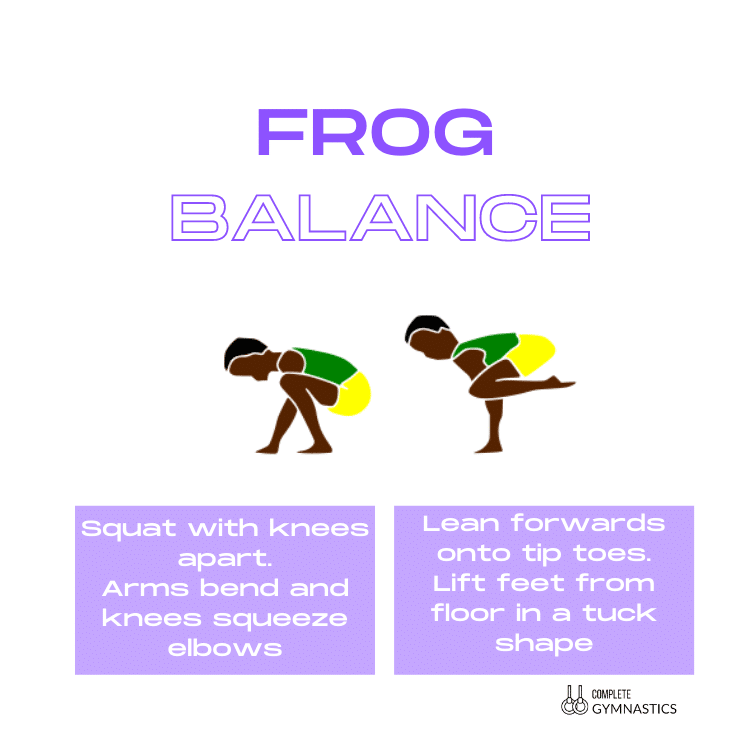
Your knees should balance on your arms around where your elbows are. For this reason, a Frog Balance can also be called an Elbow Balance.
If you want to develop this into a Headstand you would repeat but with the Head on the floor.
Pike Fold
The pike fold is essential for flexibility, stretching the hamstrings, glutes, and lower back.
A Pike fold is performed by sitting in a Pike and leaning forward so the chest is going towards the legs. Good form is important so a gymnast has to keep their leg straight, knees pressed down and toes pointed.
Gymnastics Skills A-Z
The list below covers all of the major individual skills a gymnast should learn on the floor. These skills are then used to choreograph routines and construct tumbling passes.
Acrobatic Moves
- Aerial Cartwheel
- Back Extension Roll
- Back Handspring
- Back Layout
- Back Layout 1/1 (Full Twist)
- Back Layout 1/2 (Half Twist)
- Back Pike
- Back Tuck
- Back Walkover
- Backward Roll
- Cartwheel
- Forward Roll
- Front Handspring
- Front Layout
- Front Pike
- Front Tuck
- Front Walkover
- Handstand
- Handstand Forward Roll
- Handstand Pirouette
- Round-Off
- Whip Back
Turns, Jumps and Leaps
- Cat Leap
- Double turn (720° turn)
- Full turn illusion turn
- Full turn on one foot
- Full turn with free leg at a 180° split position
- Full turn with free leg in scale above horizontal
- Half turn on one foot
- Hitch Kick
- Pike Jump
- Ring Leap
- Side Leap
- Sissone
- Split Jump
- Split Jump 1/2 turn
- Split Leap
- Straight Jump
- Straight Jump 1/1 turn
- Straddle Jump
- Straddle Jump 1/2 turn
- Switch Leg Leap
- Tour jeté
- Tuck Jump
- Tuck Jump 1/1 turn
- Wolf Jump
- Wolf Jump 1/2 turn
- Wolf Turn
Conclusion
The more time a beginner spends practicing these skills, the better they will progress and succeed with advanced skills. Is there a gymnastics skill that you would like us to create a tutorial on? Let us know and we’ll do our best to make it happen!
Gymnastics Skills FAQs
Why are some skills banned in gymnastics?
A number of skills have been banned by the FIG over safety concerns. Banned moves include the Dead Loop, Thomas Salto and Roll Out skills.
What’s the easiest gymnastics move?
The easiest recognised gymnastics move is the forward roll. It is a basic move that all beginners will practice from a young age. There are other more basic movements which are easier than a forward roll however they would not be used in even the simplest floor routines.
How do you get a gymnastics skill named after you?
To get a gymnastics skill named after you, it must be performed first at a major international competition sanctioned by the FIG. The move must be successfully executed within a routine (practice and warm ups not included).
What is the hardest gymnastics skill on floor?
The Biles II is currently the hardest gymnastics skill on floor. It has a difficulty value of J which is worth 1.0 in difficulty. To perform a Biles II you have to complete a double somersault with a triple twist in the tucked (pucked) position.
- How to Do a Back Handspring: Complete Step-by-Step GuideLearning how to do a back handspring is an exciting milestone for any gymnast. It builds confidence, agility, and forms the foundation for advanced tumbling… Read more: How to Do a Back Handspring: Complete Step-by-Step Guide
- How To Get Over a Mental Block In Gymnastics: A Complete GuideGymnastics is a sport that requires not only physical strength and skill but also mental strength. When a gymnast feels like they cannot attempt a… Read more: How To Get Over a Mental Block In Gymnastics: A Complete Guide
- The Best Leotard for Girls in 2025: What to Look ForFinding an ideal leotard for girls isn’t just about picking a dazzling design that sparkles (although it does help!). The leotard has to fit perfectly,… Read more: The Best Leotard for Girls in 2025: What to Look For
- The Best Gymnastics Shorts (Our Top Picks)The best gymnastics shorts are designed to be worn over the top of a leotard providing additional coverage around the upper legs, whilst allowing gymnasts… Read more: The Best Gymnastics Shorts (Our Top Picks)
- Decathlon Leotards – Are They Any Good?If you’re in the market for a new leotard, you may be wondering if Decathlon leotards are any good considering the low cost of their… Read more: Decathlon Leotards – Are They Any Good?
- A Complete Guide to Gymnastics Hand RipsAre you tired of dealing with painful gymnastics rips on your hands from training? Look no further – this article offers a comprehensive approach to… Read more: A Complete Guide to Gymnastics Hand Rips


